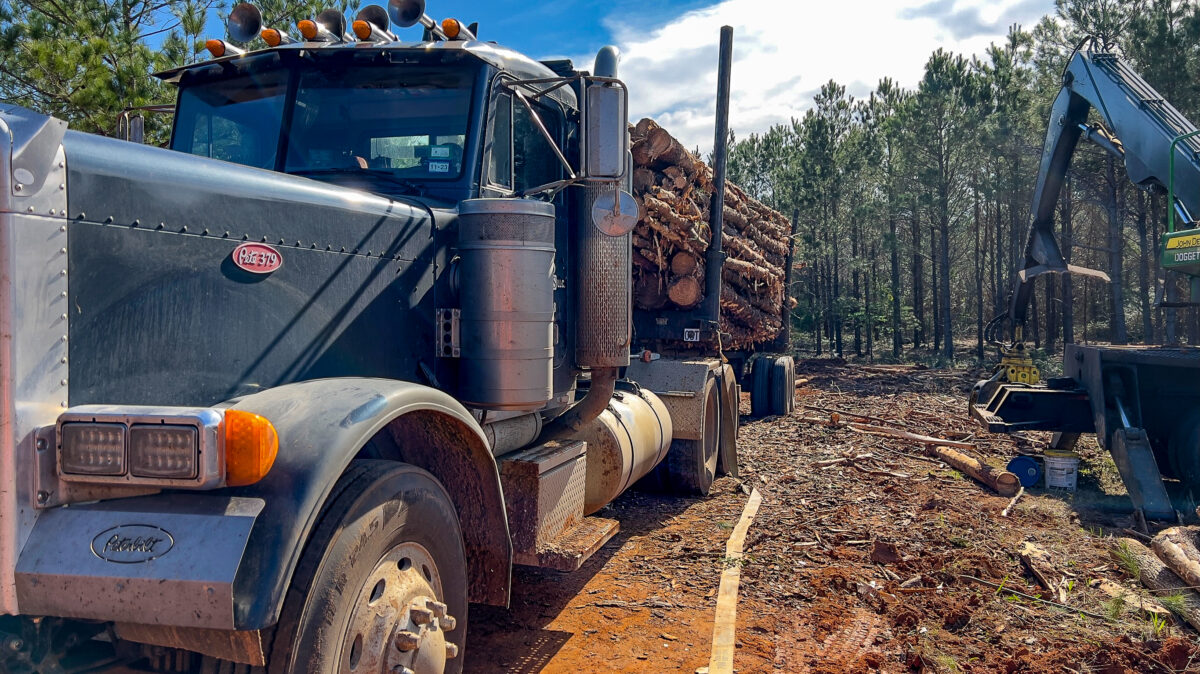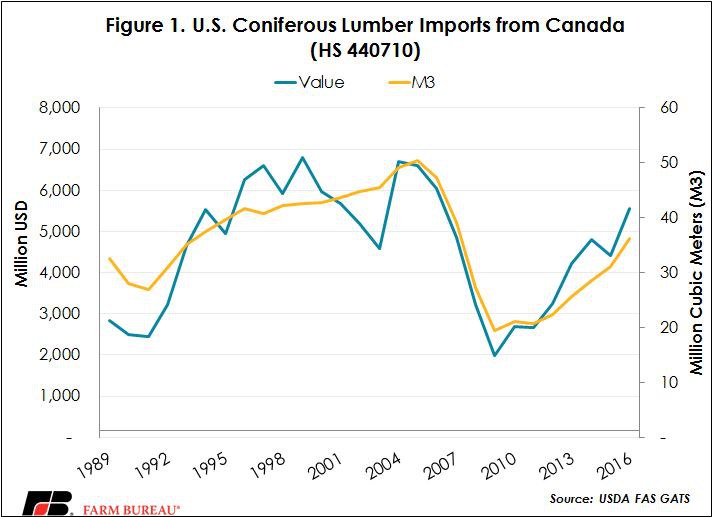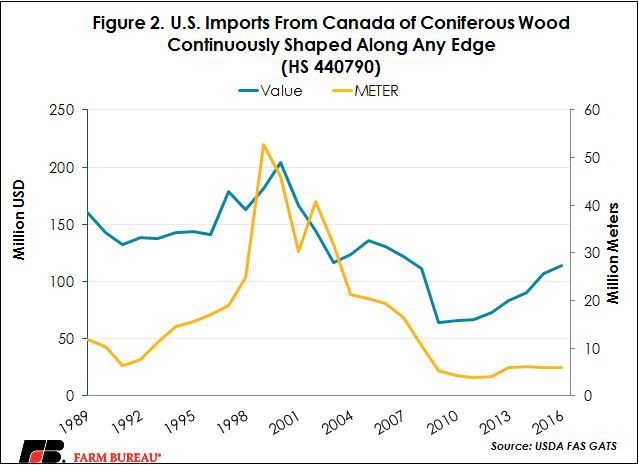If A Canadian Softwood Falls in the Woods
TOPICS
Trade
photo credit: AFBF Photo, Mike Tomko
Veronica Nigh
Former AFBF Economist
When it comes to the NAFTA discussion, one topic that has been brewing the longest, without permanent resolution, is trade in softwood lumber between the U.S. and Canada. How the governments of certain Canadian provinces price softwood logs to their logging industry has been a source of controversy for more than three decades. Actions by the U.S. and Canadian governments can be measured in rounds, and in October 2015, we entered round five. Last week, while we were enjoying the week between major holidays, the Department of Commerce kicked round five into hyper-drive by announcing new countervailing (CVD) and anti-dumping duties on certain Canadian softwood products. On January 3, we found out how significant those duties are.
The history of this dispute is long, but significant, worthy of discussion and necessary to understanding this week’s actions. The first thing to understand is that the vast majority of forests in Canada are owned by the government of the province in which they are located, and are managed on behalf of the people who live there. As a result, how the Canadian government prices timber to its logging industry has a significant impact on the overall price of Canadian softwood lumber.
In 1982, the U.S. softwood lumber industry officially filed a CVD complaint against Canadian softwood lumber exporters, due to the feeling that the Canadian government was charging less than market prices for softwood logs harvested on government land. Given that logs are the primary input of lumber, an unnaturally low input price was resulting in an unnaturally low price for Canadian lumber. However, the 1982 investigation failed to produce any results for the U.S.-lumber industry and round one came to a close.
Round two began in 1986, when the U.S. lumber industry once again filed a CVD complaint. This time, however, the DOC agreed with the industry that illegal subsidization was occurring. At this point, the DOC would normally apply CVD duties on imports, but instead of going that route the U.S. and Canada signed a memorandum of understanding, which required the Canadian government to collect a tax of 15 percent on lumber exports with the stipulation that the tax would be reduced if stumpage fees or other provincial charges increased. The MOU remained in place for 5 years, until it was unilaterally terminated by Canada in 1991.
Believing that the Canadian government had not done enough to reform their stumpage pricing, the DOC initiated a new CVD investigation, which resulted in duties of 6.5 percent on lumber from Canada, kicking off round three. Unhappy with the methodology employed by the DOC in its investigation, Canada then retaliated by requesting a bi-national dispute settlement mechanism established under the U.S.-Canada Free Trade Agreement. Because of this dispute, the DOC was forced to recalculate the CVD duties several times, but all the while collecting the 6.5 percent duties on Canadian lumber. After several years of back and forth, in 1996, a five-year agreement known as the Softwood Lumber Agreement, SLA, was reached. The agreement, which was effectively a tariff rate quota system, lasted for 5 years.
Round four began two days after the expiration of the SLA, when the U.S. lumber industry again filed a CVD complaint and for the first time also an anti-dumping complaint. After a nearly year-long investigation, in April 2002, the DOC affirmed that illegal subsidization, as well as dumping, was occurring. The final countervailing duty was found to be 18.79 percent, with antidumping duties ranged from 2.18 percent to 12.44 percent, depending on the company in question. Combined rate of the two duties ranged from 20.97 percent to 31.23 percent.
Canada responded by challenging those measures in the dispute settlement systems of NAFTA and the WTO. NAFTA panels continued to find issue with the methodology utilized by the International Trade Commission and remanded the case to refigure the charge – which kept getting lower. The WTO case was largely decided in Canada’s favor. However, the cases continued to drag on and both countries decided that a conclusion to the case would be in both countries’ favor. The new SLA went into full effect in October 2006. The agreement was for seven years, with an optional two-year extension. After an extension in 2012, the SLA expired on October 12, 2015, which meant Canadians no longer faced taxes or quota restrictions on lumber shipments to the U.S.
In an effort to increase the likelihood of coming to a new SLA, both Canada and the U.S. agreed to a one-year peace clause on trade actions after the expiration of the deal, which ended in October 2016. In November 2016, after no agreement had been reached the U.S. Lumber Coalition filed countervailing and anti-dumping duty petitions against Canadian lumber imports, setting off round five of the dispute. After USITC preliminarily found that the U.S. industry is materially injured by softwood lumber imports from Canada, the DOC issued its preliminary determination in the CVD case, with duties averaging 19.88 percent in April 2017. In June, the average AD rate of 6.87 percent was announced. The combined preliminary AD and CVD rate totaled 26.75 percent.
After the USITC affirmed in a final ruling in November that material injury was found, Commerce issued CVD and AD orders on December 28. On January 3, 2018, the final AD and CVD duties were published in the Federal Register. The average CVD duty was found to be 14.19 percent, but ranges from 3.34 to 17.99 percent. The average AD duty is 6.04, but ranges from 3.2 percent to 7.28 percent depending on the company in question. The combined average final duty is 20.23 percent, which is down considerably from the preliminary total.
Like in previous rounds of this fight, Canada has been quick to hit back. In November 2017, Canada filed a NAFTA challenge to the CVD duties and in December 2017, filed a NAFTA challenge to the AD duties. Canada also followed up with a challenge at the World Trade Organization in November 2017, claiming that the U.S. used a controversial methodology know “zeroing” in its AD duty calculation. Zeroing is a calculation methodology where in situations that the foreign domestic prices minus the U.S. import price would result in a negative number, a zero is used instead. The use “zeroing” increases the AD duty higher than it would otherwise be. The use of “zeroing” has been struck down as inconsistent with WTO law in previous cases.
Where round five of the softwood lumber dispute ends is anyone’s guess. What we can say fairly confidently, however, is that we likely won’t see a resolution anytime soon. In the meantime, learn more about the history of the dispute in the trade publication, Random Lengths. The Federal Register Notice contains a full scope of the order including the merchandise covered, as well as exclusions.


Trending Topics
VIEW ALL